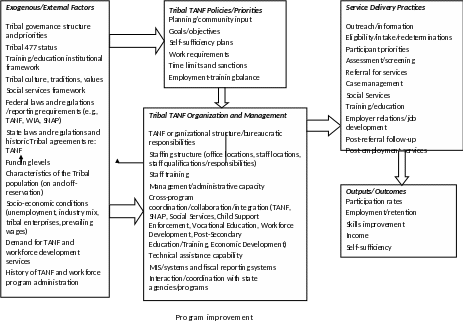Appendix 1_Conceptual Framework
Appendix 1_Conceptual Framework.docx
Descriptive Study of Tribal Temporary Assistance for Needy Families (TANF) Programs
Appendix 1_Conceptual Framework
OMB: 0970-0411
APPENDIX 1
Conceptual Framework
The design for this study is built around a conceptual framework that assumes there are many factors that influence the details of the TANF program, including the tribal culture and traditions, rationale and decisions about administering TANF, nature of and funding for workforce development programs, vocational training and economic development policies, and economic development objectives. Both factors the tribes can and cannot control may have a role in shaping implementation. The conceptual framework, depicted in Exhibit 1, identifies the logical flow from external factors that affect tribal TANF policies and management, which determine service delivery practices that, in turn, affect outputs and outcomes. The outputs and outcomes may result in changes to the external factors as well as feedback to the TANF policies and management.
External factors include the macro-economy (the broad industrial and occupational structure of the labor market), the socio-demographic characteristics of the population in need, fiscal and other resources, and federal and state laws and regulations. Tribes, like state governments, have little or no control over these external factors, yet they influence the nature of the tribal programs and, to some extent, the outcomes and performance they can achieve. Both external and internal factors can influence how a tribe organizes, structures, and manages its TANF program, and how TANF relates to other programs such as Supplemental Nutrition Assistance Program (SNAP), Head Start, social services, education, economic development, and workforce development.
The organization, structure, and management of a TANF program in turn influence how services are delivered. To a great extent, much of the “production” of a program occurs at the service delivery level: individual eligibility determination, assessment of need for services, referral to services, provision of services, follow-up, case management, and the like.
Using the conceptual framework as our guide, we will systematically document program models, service delivery approaches, client flow systems, and interprogram collaborative networks. Since a primary objective of this study is to identify and document best practices, it is critically important to consider the factors that affect replicability from one site to the next. The details of the model along with administrative information on program performance and/or evaluation findings on outcomes and impacts can be used to identify potential promising practices or “best practices” in different tribal environments and to consider the replicability of those practices elsewhere.


 Exhibit
1: Conceptual Framework for
Identifying Factors Related to Tribal TANF Implementation
Exhibit
1: Conceptual Framework for
Identifying Factors Related to Tribal TANF Implementation
| File Type | application/vnd.openxmlformats-officedocument.wordprocessingml.document |
| Author | Ting, Sarah |
| File Modified | 0000-00-00 |
| File Created | 2021-01-31 |
© 2025 OMB.report | Privacy Policy